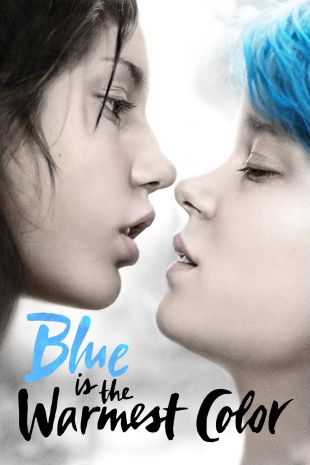
Nobody likes being a teenager, and Adèle (Adèle Exarchopoulos), the young Frenchwoman at the center of Abdellatif Kechiche's ambitious drama Blue Is the Warmest Color, is no exception. She's a high-school junior searching for love, who throws herself into her studies and puts up with a gaggle of gossipy friends who are forever trying to hook her up with one of the hottest guys in school. But it turns out that, even after she ends up in a pleasant and stable relationship with that young man, she finds herself attracted to a blue-haired woman she saw on the street.
When Adèle finally meets the alluring Emma (Léa Seydoux) there's an instant spark, and soon the two become inseparable. While Adèle is still finishing up high school, Emma is in art school and making plans for her career. Adèle eventually becomes not just her lover, but her subject and muse as well. However, their intense passion proves difficult to maintain, and as Adèle ages into her twenties, she struggles with how the two seem to be growing apart.
Blue Is the Warmest Color came out of the 2013 Cannes Film Festival with the Palme d'Or and drew a lot of attention for its explicit lesbian sex scenes and formidable three-hour running time. While few pictures can dramatically justify lasting longer than two hours, let alone three, Kechiche -- who also adapted the screenplay with Ghalia Lacroix from Julie Maroh's graphic novel -- holds the film together because he lets the individual scenes unfold slowly. The movie is long but never dull, because it feels like the director doesn't want to miss any aspect of the key moments in Adèle's life, even as he refuses to make concessions to those with short attention spans.
That attention to detail allows Exarchopoulos to deliver a powerhouse performance. Adèle is full of passion, but she keeps these powerful emotions inside her unless she has someone to direct them. Early on she shows a keen interest in literature, and she explains to her boyfriend that she loves school when she has a teacher who stokes her interest in a subject. That seems like a throwaway line, but in truth it's the spine for the entire character, and the actress finds endless permutations on how to express this central truth. Adèle seems always on the verge of tears -- whether happy or sad -- without ever once seeming like a drama queen; she feels her emotions so deeply, but she's also an introvert. That's a rich tension for any actor to throw themselves into, and Exarchopoulos explores it in ways that keep her thoroughly engaging throughout the film.

She turns out to be not just an emotional teenager, but a passionate adult as well. However, she constantly needs someone else to unleash her emotions in full, and the majority of Blue Is the Warmest Color details comprehensively how her relationship with Emma runs on this dynamic. We see lengthy and frank sexual encounters between the two that are presented just as immersively as the scenes in which they meet the other's parents for the first time, or they confront each other about infidelities, or Adèle poses so that Emma can do a nude portrait of her. The movie lets you feel like you're living this relationship in real time with these characters.
While that undoubtedly adds to the film's overpowering intimacy, it also leads to moments where as a viewer you're unsure exactly how much time has passed. There are hints and clues to help, but the lack of a clear timeline is the only element that takes you out of the movie.
However, Adèle Exarchopoulos is always there to pull us right back into her character, and her quietly commanding lead performance melds so beautifully with Kechiche's visual approach and thematic motifs that, as the closing credits roll, you understand the complicated Adèle as well as the filmmakers do -- and that makes Blue Is the Warmest Color as pure an example of humanistic empathy as you're likely to find.
